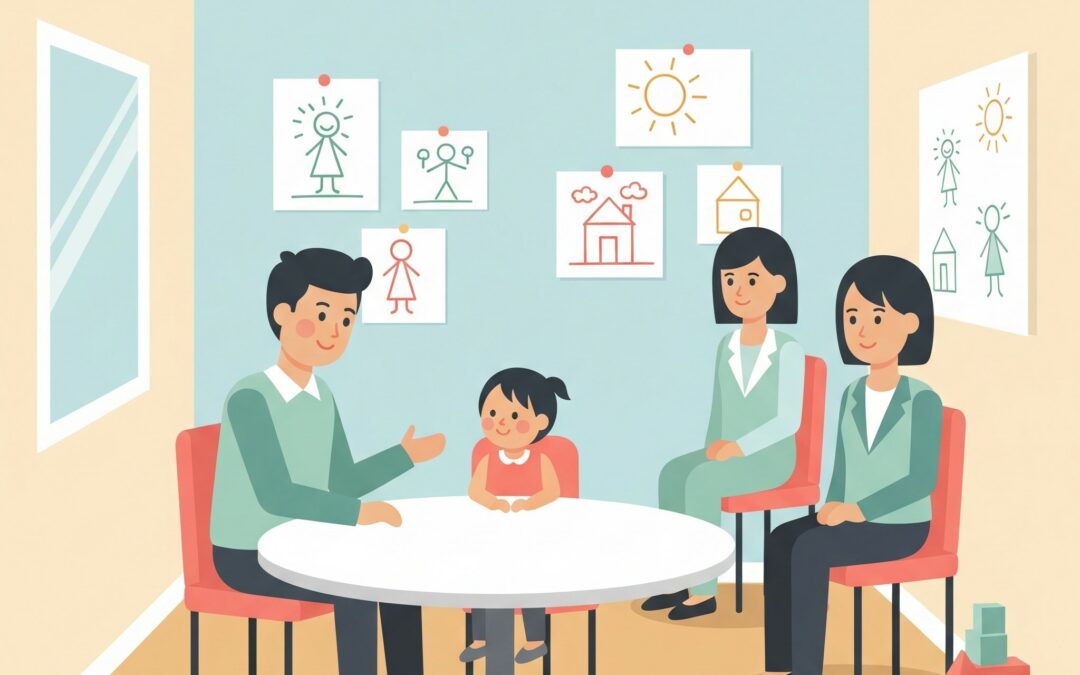Supervised visitation in a contact center—sometimes called “mediated visitation”—is a measure that the family court judge (JAF) can order in the best interests of the child when the family context or parental situation justifies it.
This special measure is intended to maintain the child’s relationship with one of the parents (or a third party) while ensuring the child’s safety and well-being.
1. Why Can a Judge Order Supervised Visitation in a Contact Center?
A family court judge resorts to supervised visitation in a contact center when handing the child over directly to the other parent presents a danger or when the child’s best interests require it.
This includes situations such as:
-
-
- Serious conflict or domestic/family violence,
- Situations where the child and parent no longer have a bond and gradual reintroduction is needed,
- High-conflict breakups where direct handover might upset or endanger the child emotionally or physically.
-
The law states that the judge may organize visitation in a contact center when direct handover presents a risk or when the child’s best interest requires it.
The judge must specifically explain the reasons for choosing this supervised setting, such as:
-
-
- Protecting the child from harm or exposure to violence,
- Reestablishing or gradually rebuilding the parent-child bond,
- Preventing conflict or psychological pressure on the child,
- Providing a neutral setting for visits in cases of extreme parental disagreement.
-
2. How Long Can the Judge Order Supervised Visitation?
The duration of the measure must be set precisely by the judge.
The judge cannot delegate to the managing association or any third party the authority to determine the length or frequency of visits.
The order must specify:
-
-
- The total duration of the measure (e.g., six months, one year),
- The frequency of visits (e.g., every other weekend, once a month),
- The length of each visit (e.g., two hours).
-
The judge may modify or terminate the measure at any time if circumstances change.
3. How Do Supervised Visits Work?
3.1. Location and Setting
Visits take place in an authorized contact center, usually managed by an association.
This neutral setting ensures the child’s safety and the calm conduct of visits.
3.2. Supervision and Practical Details
-
-
- A professional or third party is often present but not always required; the judge decides whether supervision is mandatory.
- Practical details (presence of supervisors, other participants, permission to leave the center) are specified in the court order.
- The judge may prohibit leaving the center with the child if it would present a risk.
-
3.3. Permission to Leave the Center
-
-
- Leaving the center with the child is not automatic and depends on the judge’s decision.
- If conditions are favorable, the judge may authorize outings outside the center for activities, provided it serves the child’s best interest.
-
3.4. Reporting Issues
If difficulties arise during visits, the contact center must immediately notify the judge.
4. Ending Supervised Visitation
The measure ends when:
-
-
- The period set by the judge expires (unless renewed),
- The judge modifies or terminates it due to changes in circumstances (improvement, persistent conflict, or serious incidents).
-
A request to modify or terminate can be made by:
-
-
- Either parent,
- The public prosecutor,
- The contact center’s manager (in case of major incidents).
-
The judge will then assess whether the measure is still justified, particularly if the parent-child bond has been restored, risks have disappeared, or the child expresses a wish to change the visitation arrangement.
5. Key Principles to Remember
-
-
- Supervised visitation in a contact center is an exceptional measure ordered to protect the child’s best interest.
- Only the judge can set the terms of the visits; this power cannot be delegated.
- The measure is flexible and can be adapted, suspended, or terminated depending on the circumstances.
- The judge’s decision must be clearly justified to ensure that parents, children, and professionals understand the reasons and goals of the measure.
-
For more information or to obtain personalized advice, please do not hesitate to schedule an appointment.
© Photo : AI
